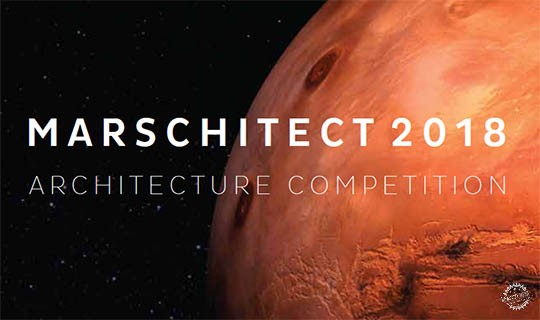竞赛:2018年MARSCHITECT建筑竞赛
发布时间:2018年04月09日 点击率:

MARSCHITECT 2018 Architecture Competition
由专筑网缕夕,李韧编译
提交日期:2018年6月30日
注册日期:2018年6月20日
语言:英文
地点:火星
奖励:请参阅下面的详细信息
类型:开放型
自宇宙诞生之际,人类始终对地球外的其他天体有着无限的好奇,因此人们渴望探索浩瀚的宇宙。人类从发明望远镜到在月球上的第一步,对于宇宙的探索是天文学、占星术、建筑学和许多其他研究领域的工作任务。今天,这种不停脚步的探索活动让我们了解到距离数千光年的星系。
在过去的几个世纪里,地球因为人类不断开发、追求更美好的生活而面临着越来越大的压力。这种持续的压力让我们的气候也发生了变化,并且对环境也造成了影响。为了减轻这种沉重的负担,我们一直在火星等其他行星上寻找资源,从而实现可持续发展的未来。
在过去的十年里,火星已经成为人们关注的焦点,也是未来人类的栖息地,通过许多组织与研究机构,人类移民火星计划似乎能够成为现实,同时,这也是人类创造乌托邦社会的一大契机。
“火星就在那儿,等着人类的开发。”——巴兹·奥尔德林 (Buzz Aldrin),他是美国前宇航员(他和任务官尼尔•阿姆斯特朗(Neil Armstrong)是最先登陆月球的人类)
挑战
竞赛面向建筑师、设计师、学生、老师、工程师、艺术家、梦想家,以及所有相信未来乌托邦空间的相关人士。参赛者将为火星的初始居民(由五名研究人员组成)设计一个自我维持生活的空间站。
这些研究人员将进一步研究和探索火星,以了解生活居住和其他人类的必需生活资源。这5位研究人员由层层测试挑选而出,他们经过严谨的学习,将去证实火星上是否存在生命这一大疑问。
参赛者将为这五位研究人员设计满足需求的可持续空间。
该计划的空间包括:生活区域、5个睡眠区域、烹饪区域、研究区域、交互空间、卫生和浴室区域、娱乐区域、受控农场区域,及其参赛者认为合理的其他场所。
参赛者可任意选择火星场地。
对于人类来说,星际旅行不是一个遥不可及和创新的想法,不断地探索会让这个想法终成现实。现在人们可以通过想象来创造未来,通过设计构思出在火星上的未来建筑前景。
“在火星上,你可以开始一个具有自我意识的城市文明,并将它发扬光大。”——Elon Musk ,Visionary Tesla 和 SpaceX创始人
奖励
奖金总额为4000美元,细分如下:
一等奖:2000美元+证书+奖杯+出版物
二等奖:1200美元+证书+奖杯+出版物
三等奖:800美元+证书+奖杯+出版物
10 名荣誉提名:证书
获奖者作品将于Volume Zero网站和相关国际建筑和设计杂志上发表。
为了表示我们对参赛者的认可,所有参赛者都会收到参赛证书。
时间安排
提前注册日期:2018年3月20日至2018年5月18日
标准注册日期:2018年5月19日至2018年6月20 日
提问截止日期:2018年6月10日
作品提交截止日期:2018年6月30日
获奖者公布日期:2018年8月20日
注册
提前报名注册:
印度参赛者 - 每个团队1800卢比
其他国家参赛者 - 每个团队65美元
标准注册:
印度参赛者 – 每个团队2400卢比
其他国家参赛者 – 每个团队85美元
评判标准
入围参赛作品将由评委小组进行评选,小组成员都是业内的专业人士。评委会将按照以下标准对提交的参赛作品进行评选:
设计理念:根据参赛者参赛作品的创意能力进行评判,通过创新思维进行设计。
结合气候:对于火星的严酷环境、设计的可行性,应予以认真考虑。
空间配置:火星空间站内需设置有所有必要的功能空间。
参赛资格
2018年MARSCHITECT建筑设计竞赛面向所有人开放,建筑师、学生、工程师、产品设计师、思想家、公司、组织等相关专业人士均可参赛,欢迎提交设计理念。本次竞赛不需要专业资格。
竞赛网站:http://marschitect.volzero.com/
Submission: June 30, 2018
Registration: June 20, 2018
Language: English
Location: Mars
Prizes: Please see details below
Type: Open
Since the start of time, we humans have been captivated by the mystical nature of other celestial bodies surrounding our Planet Earth. This fascination has been translated to works of astronomy, astrology, architecture and many other studies from making a simple telescope to humankind’s first steps on the Moon. This unending drive for exploration has today led us to understanding our neighboring solar systems and galaxies, thousands of light years away.
The last few centuries have seen our Mother Earth grappling with mounting pressure towards her resources due to mankind’s quest for a better life. This persistent pressure has now compounded into unpredictable and irrevocable changes in our climatic conditions and atmosphere. To relieve this mounting weight, we have been taking huge strides in our efforts to find resources on other planets like Mars for a clean and sustainable future.
The previous decade has witnessed MARS as the centre of attention for becoming a potential new habitat for the earth’s future population, resulting in a Martian race. With many visionary organizations and their ground-breaking explorative studies and research, the unseen future of inhabiting the Red Planet is now a real possibility; an opportunity to create a utopian tomorrow, making mankind a multi-planetary species.
“Mars Is There, Waiting To Be Reached.”-Buzz Aldrin
Former Astronaut (he and mission Commander Neil Armstrong were the first two humans to land on the Moon)
THE CHALLENGE:
We invite architects, designers, students, teachers, engineers, artists, visionaries, and everyone who believe in this unseen future and a possibility of utopian future. The participants are to create a self-sustaining living space for the initial habitants, a group of five researchers, of the Red Planet.
These researchers are to further study and explore mars to understand its resources for inhabitation and other human necessities. The 5 researchers have been carefully selected to understand various parameters to validate the idea for the existence of life on Mars.
The participants are to design functional, sustainable spaces that cater to the needs of these five researchers.
The spaces for the program include: Living Area l Sleeping Area for five l Cooking Area l Research Area l Interaction Spaces l Areas for Sanitation and Bath l Recreation Area l Controlled Areas for Farming l Any other spaces that the participant wish to specify
The participants are to select a location anywhere on the topography of Mars.
With interplanetary travel for humans not a far-fetched idea and innovations made every day to make it a reality soon. It is now time to imagine and create a new civilization. A civilization the world has dreamt with an opportunity to design the future architectural prospect on the Red Planet for others to follow.
“At Mars, you can start a self-sustaining civilization and grow it into something really big.”
-Elon Musk
Visionary Tesla and SpaceX founder
AWARDS
Prizes of total USD 4000, broken down as follows:
1st Prize: USD 2000 + Certificate + Trophies + Publication
2nd Prize: USD 1200 + Certificate+ Trophies + Publication
3rd Prize: USD 800 + Certificate+ Trophies + Publication
10 Honorable mentions: Certificates
Winners and honorable mentions will be published on Volume Zero website and several international architecture and design magazines.
To show our appreciation, all the participants would receive participation certificate.
SCHEDULE
Early Bird Registration: 20th March 2018 to 18th May 2018
Standard Registration: From 19th May 2018 to 20th June 2018
Last Day for Queries: 10th June, 2018
Closing Date for Submission: 30th June 2018
Announcement of Winners: 20th August 2018
REGISTRATION
Early Bird Registration:
Participants from India – INR 1800 (per team)
Participants from Other Countries – USD 65 (per team)
Standard Registration:
Participants from India – INR 2400 (per team)
Participants from Other Countries – USD 85 (per team)
JUDGING CRITERIA
The final entries will be judged by an esteemed panel of judges who are experts in the subject matter. The jury panel will judge the submitted entries as per the criteria mentioned below:
Design Concept: The participants’ entries will be judged based on their imaginative capabilities to develop a concept and their approach towards designing the habitat in terms of innovation.
Climatically Responsive: The feasibility of the designs oppose the stark atmosphere of the Red Planet is to be given careful consideration.
Spatial Configuration: The spaces in the habitat pod have to be functional for all the necessary operations.
(该文章来源网络,如有侵权请联系15212443003,我们将第一时间进行删除)



